#catherine : ruby wedding gift necklace.
Text
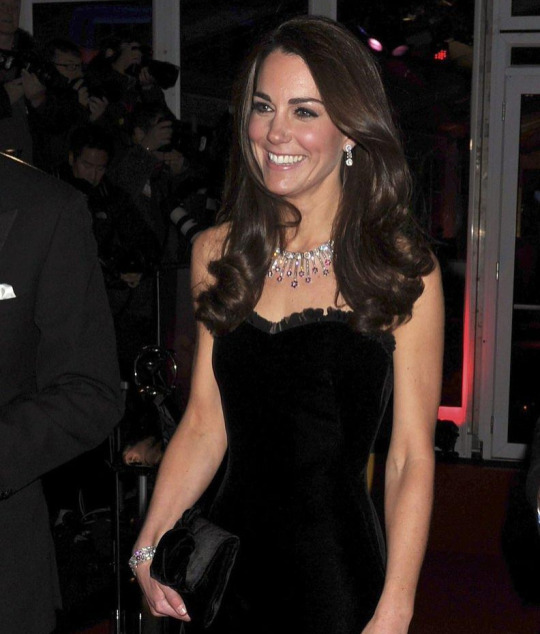
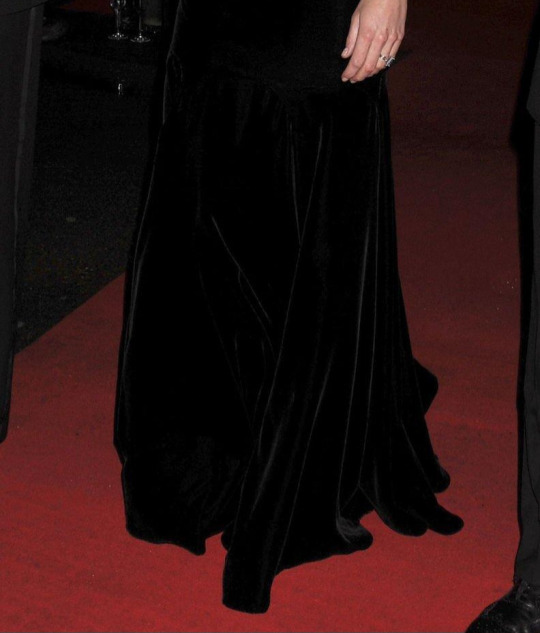
CATHERINE'S STYLE FILES - 2011
19 DECEMBER 2011 || The Duchess of Cambridge attended The Sun Military Awards at Imperial War Museum in London along with Prince William.
#catherines style files#style files 2011#19.12.2011#sun military awards 11#ballgowns#princess of wales#princess catherine#royal fashion#fashion#alexander mcqueen.#jimmy choo.#catherine in prada.#prada.#mascaro.#pretty ballerinas.#mouawad.#mouawad ruby demi parure.#catherine : mouawad wedding gift necklace.#catherine : mouawad wedding gift necklace#catherine : mouawad wedding gift bracelet.#catherine : mouawad wedding gift bracelet#catherine : mouawad ruby demi parure.#catherine : mouawad ruby wedding gift bracelet.#catherine : mouawad ruby wedding gift necklace.#catherine : mouawad ruby wedding gift parure#catherine : mouawad wedding gift suite.#catherine : mouawad ruby wedding gift suite.#catherine : ruby wedding gift bracelet.#catherine : ruby wedding gift necklace.#catherine : ruby wedding gift suite
28 notes
·
View notes
Text
Mouawad Demi Parure
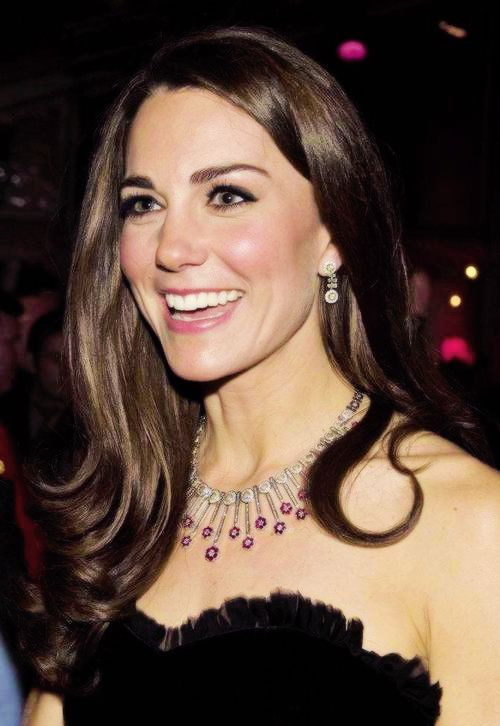
Personal Jewels 2/?
Unfortunately gifts are not usually publicized anymore but sometimes assumptions can be made.
In December 2011 for the Sun Military Awards, Catherine wore a diamond and ruby necklace with a matching bracelet. This set of jewels was made by Mouawad and is assumed to have been a wedding present to the Duchess. It’s giver is not known. The set hasn’t been worn since but last year for the Commonwealth Day Service at Westminster Abbey, Catherine wore for the first time the matching earrings for the set.
The necklace and earrings feature diamond circles with a modern style fringe from which are suspended ruby clusters in the shape of flowers. The bracelet consists of alternating diamond circles and ruby clusters.
~ British Royal Jewels IG
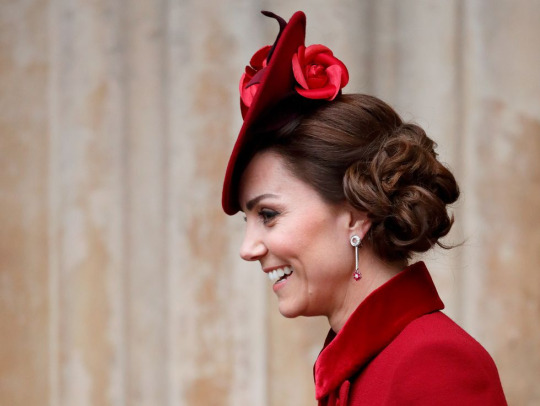
#personal jewels#princess of wales#jewel;necklace#jewel;earrings#jewel;bracelet#british royal family#Mouawad Demi Parure
98 notes
·
View notes
Photo
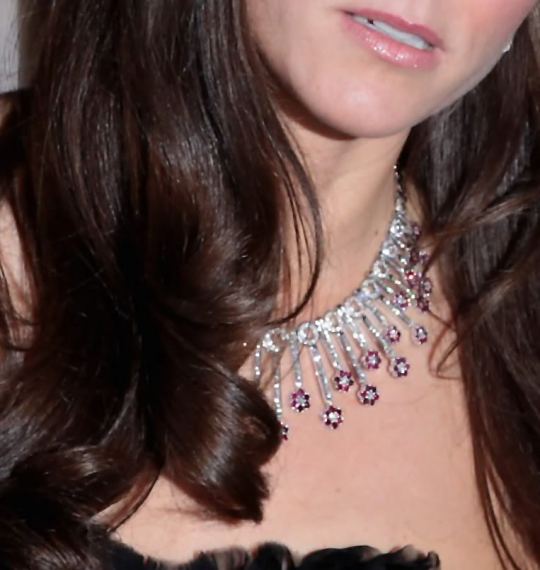
Mouawad Necklace ♕ The Princess of Wales
#Mouawad#mouawad necklace#kate middleton#catherine middleton#Catherine Duchess of Cambridge#duchess of cambridge#ruby jewelry#ruby necklace#royal wedding gift#Diamond Jewelry#diamond necklace#ruby jewels#diamond jewels#personal jewelry#personal property#british royal family#british royal jewels#Windsor#House of Windsor#windsor royal family#Windsor Royal Jewels#royal jewels#Princess of Wales#Catherine Princess of Wales
93 notes
·
View notes
Text
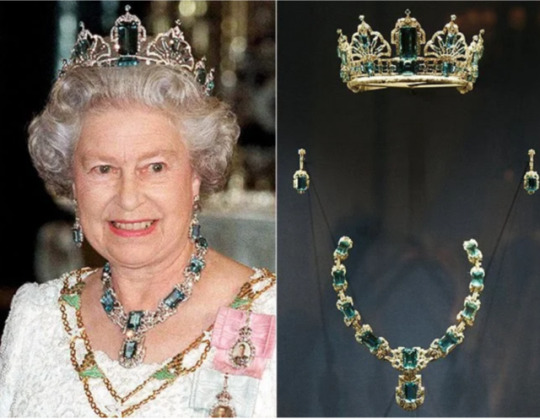
BRAZILIAN AQUAMARINE TIARA
After receiving an aquamarine necklace and pair of earrings from the president and people of Brazil in honor of her coronation, the Queen had Garrard and Co., the former Crown Jeweler of the United Kingdom, make this matching tiara in 1957. She's continued to update it through her reign, adding even more aquamarines and diamonds to the (already stacked) piece.
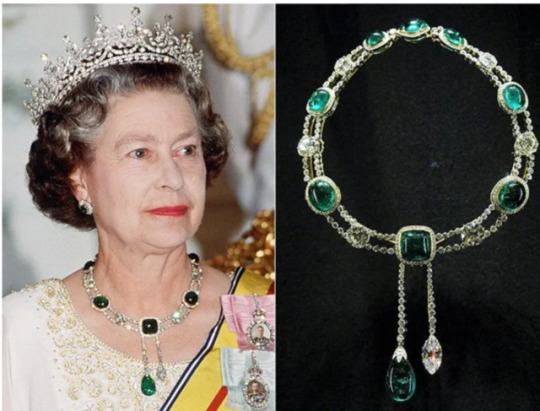
DELHI DURBAR NECKLACE
The Delhi Durbar was India's answer to a coronation, a massive gathering to celebrate the succession of a new Emperor or Empress of India. And just like at a coronation, there are jewels aplenty – including this diamond-and-emerald necklace made for Queen Mary for the event.
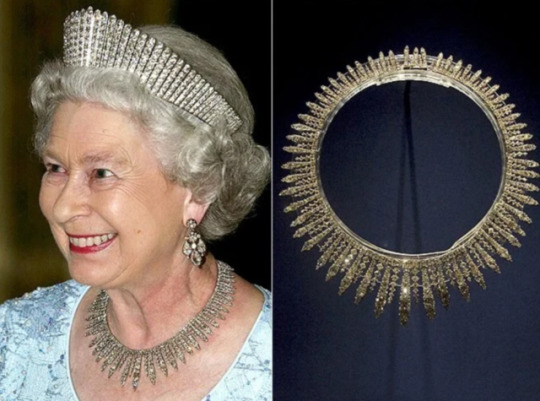
DIAMOND FRINGE TIARA City of London Necklace
*edited* The Queen is shown wearing the Queen Alexandra's Kokoshnik Tiara in this picture. The necklace is the City of London Necklace, which was a wedding present from the City of London. Thanks to @europesroyals I learned something new!
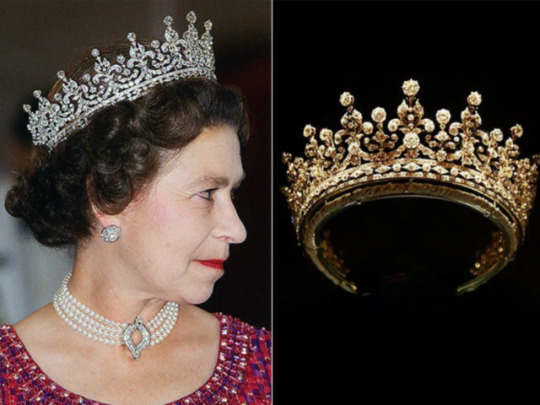
GIRLS OF GREAT BRITAIN AND IRELAND TIARA
Originally purchased for the future Queen Mary by a committee of girls from Great Britain and Ireland to celebrate her 1893 wedding, this tiara is now a staple in Queen Elizabeth's rotation – many even say it's her favorite. It's been through many changes in its life: There were originally pearls on top of the points, which now are a part of the Cambridge Lover's Knot tiara, and it can be worn both with or without a base. The Queen received the tiara as a wedding gift from her grandmother in 1947.
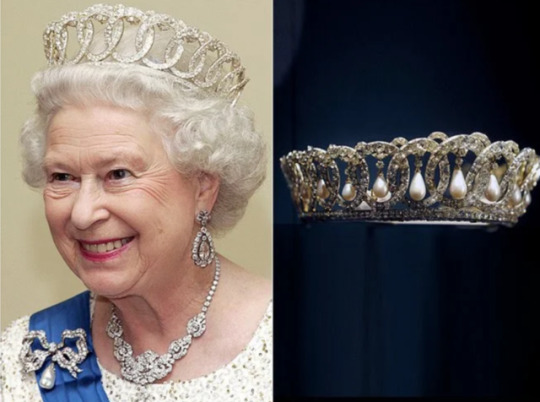
GRAND DUCHESS VLADIMIR OF RUSSIA TIARA
This diamond-and-pearl tiara is a relic of a lost monarchy: It originally belonged to Grand Duchess Vladimir, the aunt of Nicholas II, the last tsar of Russia. It currently has a alternate of emeralds to replace the pears on any occasion. She was temporarily separated from the tiara after fleeing St. Petersburg during the Russian Revolution, but was reunited with the piece a few years later when a British Secret Intelligence Service member rescued her jewels from Russia. After all that, she gave the tiara to her daughter, Princess Nicholas of Greece, who sold it to Queen Mary after her mother's passing. When Mary died, the Queen inherited it – and still wears it today.

KING GEORGE IV STATE DIADEM
This piece was created way back in 1820 for the coronation of King George IV. Now, people may recognize it from the State Opening of Parliament – Queen Elizabeth wears it in the procession to the event every year.
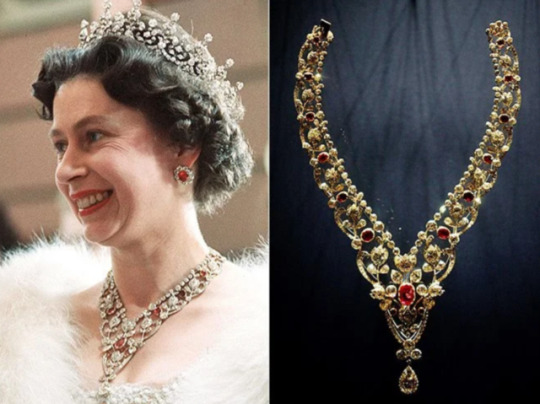
RUBY BANDEAU NECKLACE
This diamond-and-ruby necklace with floral detailing was another wedding gift to Queen Elizabeth from her parents, King George VI and Queen Elizabeth (and all your parents got you was a blender). It was frequently worn by the Queen in her younger years.
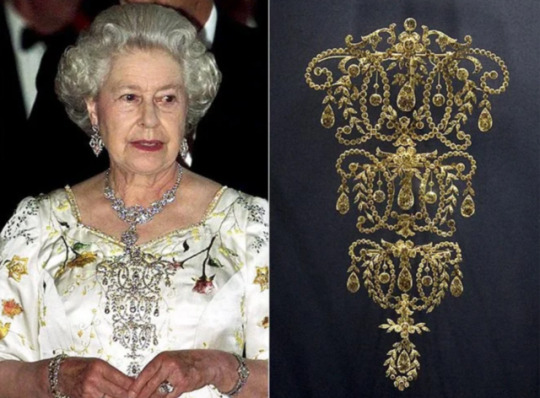
QUEEN MARY DIAMOND STOMACHER
This piece is a stomacher – best described as an enlarged brooch worn on the front of a dress. Queen Mary handed it down to her granddaughter, then-Princess Elizabeth, as a wedding present back in 1947, although due to changing fashions, the entire stomacher is rarely worn nowadays.
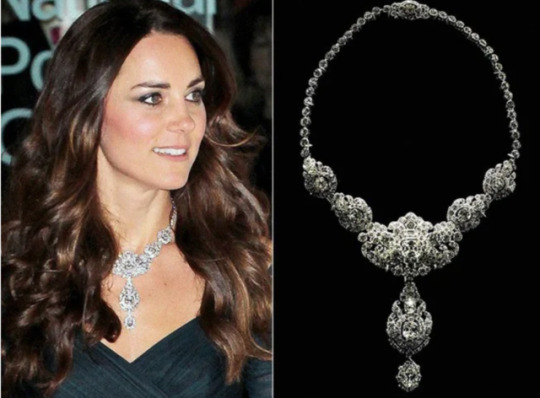
NIZAM OF HYDERABAD NECKLACE
This Cartier-crafted piece was given to Queen Elizabeth, again as a wedding present, by a dignitary. It was most recently seen on Princess Catherine, Duchess of Cambridge during an event at the National Portrait Gallery in London.
- People.com
#royal jewels#queen Elizabeth II#tiaras#grand Vladimir diamond tiara#girls of great britian and Ireland tiara#Brazilian Aquamarine Tiara#delhi durbar necklace#queen Alexandra's Kokoshnik Tiara#the city of london necklace
40 notes
·
View notes
Note
Hello, I've been reading some articles on Catherine's jewelry that she received for wedding, the famous being the Red ruby necklace and bracelet that she wore with the black Alexander McQueen gown, how come it's controversial and why doesn't she wear it any more? I apologize for my bad English. Thank You for answering this question!
Hello :) I don’t recall a particular controversy around it but it was from Mouawad who are an Emirati firm. Perhaps due to the possible optics of wearing a highly expensive designer piece from that part of the world it was felt that it would be better not to tempt fate, but they’ve never commented on it more than saying it was a gift
Also your English is magnificent, you don’t have to apologise!
10 notes
·
View notes
Note
Thomas and Amanda Headcannon Girlfriend gift- diamond that could choke a T-Rex Engagement gift - A small country cottage (actually it's a huge Castle by the sea) Wedding gift - a ruby ring own by Catherine the Great Push Gift - A largest Private island 🌴 I believe when he finally comes around he well making up for lost time.
Amanda: Am I getting a diamond necklace, Thomas?
Thomas: Well, I don’t see why not then. They’re right, I should make up for lost time.
7 notes
·
View notes
Text
September Birthstones and Flowers
Sensational Sapphire
A symbol of purity and wisdom, sapphire is the birthstone for September.
At one time sapphires were believed to protect the wearer against evil and poison. Sapphires were even thought to be capable of killing spiders and venomous snakes.
Sapphires are a form of the mineral corundum. Blue is the color associated with this precious gem, but sapphires can also be white, yellow, orange, green, and purple. There are no red sapphires, as all corundum in red hues are rubies. The sapphire, and it sister stone, the ruby, are second only to the diamond in hardness. Sapphires are found in Eastern Australia, Thailand, Sri Lanka, China, Madagascar, East Africa, and North America (primarily in Montana).
A six-rayed "star" can appear on a sapphire when the underlying crystal structure has just the right pattern of needle-like inclusions. This is known as a "star sapphire."
Down the ages, sapphires have been popular with royalty. When Prince Charles and Lady Diana Spencer became engaged in February of 1981, Charles offered her a choice of a dozen rings, and she selected a 12 carat blue oval Ceylon sapphire surrounded by 14 diamonds, set in white gold. The ring was not a custom piece, and was available in the jeweler's catalog, but Diana chose it because it was the most beautiful. (She was also very fond of sapphires.) When their son, Prince William, became engaged to Catherine Middleton in 2010, he gave his bride-to-be, the future Duchess of Cambridge, the ring his mother had loved.
Diana, Princess of Wales, also received some fabulous sapphire jewelry as wedding gifts. The Queen Mother gave her a large oval sapphire and diamond brooch. Diana had it converted into the clasp of a seven-strand pearl choker, and wore it often. It was magnificent. Crown Prince Fahad of Saudi Arabia gave her a set of sapphire jewelry, including a watch, earrings, a bracelet, and a beautiful diamond necklace with a sapphire and diamond pendant.
Chrysolite: September Birthstone Emeritus
Before birthstones were standardized in 1912, chrysolite was a September gem. Today, chrysolite can refer to peridot, the gem-quality form of olivine that is the birthstone for August. It is also an archaic term for yellow to green stones including topaz, chrysoberyl, zircon, tourmaline, and opatite.
In the New Testament Book of Revelations, 21:19, chrysolite is named as the precious stone garnishing the seventh foundation of the city wall in New Jerusalem.
Aster and Morning Glory: Hardy Beauties
The aster and the morning glory are the birth month flowers for September.
A genus of the flowering plant family Asteraceae, the aster is a daisy-like flower known since ancient times.This hardy flower brings a pop of color to a late summer and early autumn garden, and symbolizes patience and powerful love.
The name aster comes from the Greek word astḗr, meaning "star," because of its ray-like petals. In Greek mythology, the compassionate goddess Astera, distraught when Jupiter caused a destructive flood, asked to be turned into a star, then wept for the dead. Her tears became asters.
The Ancient Greeks believed burning the leaves of this plant could drive away snakes, similar to the way sapphire’s properties were supposed to kill serpents.
“White Aster” is an epic Japanese poem written in 1889 by Ochai Naobumi, about a maiden found as a child among white asters.
The morning glory opens early in the morning, hence the common name for more than 1,000 species in the flowering plant family Convolvulaceae. Some varieties are especially suited to creating summer shade on trellises. Their attractive flowers can even thrive in poor, dry soil.
Morning glories symbolize affection. Perhaps because this is a robust plant with short-lived flowers, there is a duality to it. In Victorian times it was a symbol of undying love, and also of unrequited love. Because the flowers bloom and die within a short space of time, morning glories often decorated the graves of children.
American artist Georgia O'Keefe’s many beautiful flower paintings include her well-known 1935 work, "Blue Morning Glories.”

E. Nash 1908 postcard for September, from the Birthday Gems series.
My E. Nash postcard for September, from their 1908 Birthday Gems series, has a sapphire stickpin in the upper right corner, beneath a gold “guiding star.” “September” appears in the upper left corner, above a framed verse, and a spray of pink asters that spans most of the card. The greeting “Wishing you a Happy Birthday” is centered at the bottom. The verse reads:
The Sapphire of heavenly hue
Brings great wisdom unto you
The blooming Aster tells you true
Life’s happiness you will never rue
Thy Star shines out from the sky above
And its rays disclose the light of Love
I like the color and composition, the shadowing, and the way the asters and stickpin are partially in the bottom border.
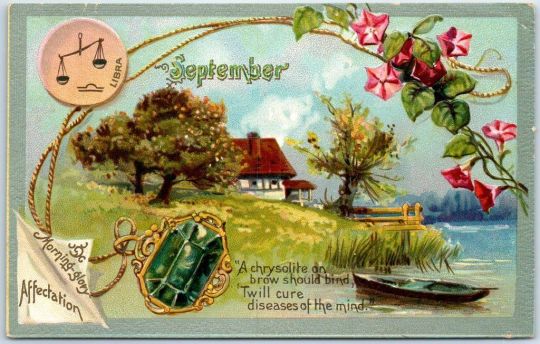
Tucks astrology postcard for September, circa 1910.
I also have a Tucks postcard from about 1910 from an astrology-based birthday series, with the sign “Libra” next to the word “September.” A landscape with a house by water and a small boat are framed with morning glories and a chrysolite pendant. The words “Morning-glory” and “Affectation” (not “Affection”!) are in the lower left corner, and centered at the base of the card is the verse:
“A chrysolite on
brow shall bind,
‘Twill cure
Diseases of the mind.”
This month I remember the birthday of my dear “Betty Mom,” Betty Jean Wible, and wish all September babies a happy birthday!
#SeptemberBirthstones#sapphire#chrysolite#SeptemberFlowers#Aster#MorningGlory#DianaPrincessOfWalesSapphires#ENashBirthdayPostcards TuckSeptemberpostcard
4 notes
·
View notes
Text
Stunning September Sapphires
September babies are some of the lucky few who have a wide selection of birthstones to claim as their own. A variety of the corundum mineral, the sparkling sapphire, is the birthstone for this lovely fall month. Typically, most people envision the color blue when they think of this gemstone, but there is actually a wide selection of colors to choose from. Next to diamonds, the sapphire is one of the most popular and durable gemstones. Whether you’re looking for a way to treat yourself to a birthday present or purchase a gift for a September-born friend or loved one, sapphire jewelry is an excellent choice.
History of Sapphires
There is a great deal of myth and lore regarding sapphires. The name sapphire is derived from “sapphirus,” the Greek word for blue. The ancient Greeks believed that sapphires were connected to the spirit world. They’re most often associated with the god Apollo, the Greek god of prophecy. Those who practiced sorcery believed that sapphires could grant them access to enlightenment and higher consciousness. Ancient Persian civilizations believed that blue sapphires were remnants of a pedestal upon which the earth stood, the reflection of which gave the sky its blue coloring. Sapphires have long been a symbol of divine wisdom and purity, which is why the gemstone was often reserved for members of the clergy, high priests and kings. The sapphire was even regarded as a holy stone by the Catholic church.
Sapphires have long been associated with royalty and have been worn by kings and queens throughout history for their powerful defensive properties. As far back as biblical tales, King Solomon and Abraham were believed to have worn talismans fashioned with sapphire. The stone is also often associated with the British Royal Family. Queen Elizabeth II has a collection of sapphire jewelry, pieces of which once belonged to Queen Victoria and Prince Albert. She is frequently pictured in a sapphire necklace and earring set gifted to her by her father King George VI for her wedding. In addition, Prince Charles famously gave Princess Diana a sapphire engagement ring which is now worn by Prince William’s bride Catherine, the Duchess of Cambridge.
The world’s largest gem quality blue sapphire was unearthed in Sri Lanka and was given the name Star of India. Though it once belonged to banker J P Morgan, this magnificent gem is now housed in the American Museum of Natural History in New York City. The Star of India is said to be cursed, as it was stolen from the museum in the 1960’s by a group of burglars who made off with the sapphire and a handful of other precious gems, though luckily the sapphire was later recovered. Sapphires are most frequently mined in India, Myanmar, Vietnam, Australia, Brazil and China, but the world’s largest sapphire trading center is in Thailand. However, here in North America, Montana mines are known for producing delicately hued yellow and pink as well as cornflower blue sapphires – the purest blue colored and most highly coveted variation of the sapphire.
Along with being prized as September’s gemstone, sapphires are given to commemorate 5th, 45th, and 70th wedding anniversaries.
Now that you’re familiar with the history of sapphires, and their unique properties, there’s only one question left to ask yourself—what color sapphire should you choose?
The Rainbow of Sapphires
The most popular color of sapphires is blue, but the September birthstone comes in shades of the entire rainbow. From blue, to pink, to yellow and more, each different colored sapphire holds a different meaning. Depending on who you’re shopping for, the color you choose can make the gift even more special.
Blue Sapphires
Blue is the most popular and well-known color of sapphires. This color of the September birthstone can be found in shades ranging from light blue to a dark, vivid violet. Blue sapphires have been held in high regard for many centuries and, as previously mentioned, are typically associated with royalty. They are also considered to be symbols of love, loyalty, wisdom, and power. Treat any September baby to a gift of blue sapphire jewelry and she is sure to feel like a queen.
Blue sapphires are also a modern alternative to diamonds for engagement rings. If perhaps you are planning a special birthday proposal for the September baby in your life, a blue sapphire is an excellent choice to represent your love, in addition to the month of her birth.
Pink Sapphires
The hues of pink sapphires range from pale pink to a stunning, vibrant deep pink. But do not get confused with the color red. Red is the only color exception for sapphires; a “red sapphire” is actually a ruby. Pink sapphires are in high demand due to their beautiful peachy color and their excellent light reflection. All of the various shades of pink sapphires are considered to be the most universally complementary stone color to all skin tones. No matter what kind of sapphire jewelry you choose, it is sure to dazzle against her skin. A gift of pink sapphire jewelry is also even more meaningful as it represents inner resilience, strength, and good fortune.
Yellow Sapphires
Bright and cheery, a gift of yellow sapphire jewelry is sure to put a smile on anyone’s face. This color of the September birthstone can range in shade from greenish-yellow to orangish-yellow; however, the most popular shade is a bright canary yellow. Since fancy colored yellow diamonds are so popular, a less expensive alternative is a yellow sapphire. But you certainly won’t be sacrificing any beauty or brilliance. Yellow sapphires are considered to be bearers of wisdom, prosperity, and good luck. They are also some of the largest cut sapphires, making this shade of the September birthstone the perfect gift for anyone who loves big, bold jewelry.
Padparadscha Sapphires
If you’ve never heard of a padparadscha sapphire, you’re not alone. In fact, this particular September birthstone is the rarest color of the gemstone. It is also one of the rarest gemstones in the world! The combination of pink, orange and yellow creates a padparadscha sapphire. Their beauty is unprecedented and extremely striking as they resemble sunsets, lotus flowers, and other tropical settings. The appeal of this gemstone is its uniqueness and rarity, making it the perfect gift for your one-of-a-kind loved one who has a September birthday.
In addition to all of these gorgeous colors, there is actually one more version of sapphire: the white sapphire. Technically speaking, white sapphires are actually not white. They are simply colorless and transparent since no trace elements are found in the mineral. White sapphires are not to be confused with diamonds, but they do make excellent gifts for those who are fond of brilliant, sparkling gemstones.
The Best Place to Buy September Birthstone Jewelry in San Diego
No matter what color you’re looking for, Leo Hamel Fine Jewelers has one of the widest assortments of September birthstones in San Diego. From rich blues to vibrant pinks and even pastel yellows, it’s easy to find the perfect sapphire jewelry gift from our collection. Stop by our San Diego jewelry store today to browse the wide spectrum of sapphires and find the perfect gift to represent your September born-loved one.
The post Stunning September Sapphires appeared first on Leo Hamel Fine Jewelers Blog.
from https://www.leohamel.com/blog/index.php/2018/09/stunning-september-sapphires/
from https://leohameljewelry.tumblr.com/post/177785375752
0 notes
Text
Stunning September Sapphires
September babies are some of the lucky few who have a wide selection of birthstones to claim as their own. A variety of the corundum mineral, the sparkling sapphire, is the birthstone for this lovely fall month. Typically, most people envision the color blue when they think of this gemstone, but there is actually a wide selection of colors to choose from. Next to diamonds, the sapphire is one of the most popular and durable gemstones. Whether you’re looking for a way to treat yourself to a birthday present or purchase a gift for a September-born friend or loved one, sapphire jewelry is an excellent choice.
History of Sapphires
There is a great deal of myth and lore regarding sapphires. The name sapphire is derived from “sapphirus,” the Greek word for blue. The ancient Greeks believed that sapphires were connected to the spirit world. They’re most often associated with the god Apollo, the Greek god of prophecy. Those who practiced sorcery believed that sapphires could grant them access to enlightenment and higher consciousness. Ancient Persian civilizations believed that blue sapphires were remnants of a pedestal upon which the earth stood, the reflection of which gave the sky its blue coloring. Sapphires have long been a symbol of divine wisdom and purity, which is why the gemstone was often reserved for members of the clergy, high priests and kings. The sapphire was even regarded as a holy stone by the Catholic church.
Sapphires have long been associated with royalty and have been worn by kings and queens throughout history for their powerful defensive properties. As far back as biblical tales, King Solomon and Abraham were believed to have worn talismans fashioned with sapphire. The stone is also often associated with the British Royal Family. Queen Elizabeth II has a collection of sapphire jewelry, pieces of which once belonged to Queen Victoria and Prince Albert. She is frequently pictured in a sapphire necklace and earring set gifted to her by her father King George VI for her wedding. In addition, Prince Charles famously gave Princess Diana a sapphire engagement ring which is now worn by Prince William’s bride Catherine, the Duchess of Cambridge.
The world’s largest gem quality blue sapphire was unearthed in Sri Lanka and was given the name Star of India. Though it once belonged to banker J P Morgan, this magnificent gem is now housed in the American Museum of Natural History in New York City. The Star of India is said to be cursed, as it was stolen from the museum in the 1960’s by a group of burglars who made off with the sapphire and a handful of other precious gems, though luckily the sapphire was later recovered. Sapphires are most frequently mined in India, Myanmar, Vietnam, Australia, Brazil and China, but the world’s largest sapphire trading center is in Thailand. However, here in North America, Montana mines are known for producing delicately hued yellow and pink as well as cornflower blue sapphires – the purest blue colored and most highly coveted variation of the sapphire.
Along with being prized as September’s gemstone, sapphires are given to commemorate 5th, 45th, and 70th wedding anniversaries.
Now that you’re familiar with the history of sapphires, and their unique properties, there’s only one question left to ask yourself—what color sapphire should you choose?
The Rainbow of Sapphires
The most popular color of sapphires is blue, but the September birthstone comes in shades of the entire rainbow. From blue, to pink, to yellow and more, each different colored sapphire holds a different meaning. Depending on who you’re shopping for, the color you choose can make the gift even more special.
Blue Sapphires
Blue is the most popular and well-known color of sapphires. This color of the September birthstone can be found in shades ranging from light blue to a dark, vivid violet. Blue sapphires have been held in high regard for many centuries and, as previously mentioned, are typically associated with royalty. They are also considered to be symbols of love, loyalty, wisdom, and power. Treat any September baby to a gift of blue sapphire jewelry and she is sure to feel like a queen.
Blue sapphires are also a modern alternative to diamonds for engagement rings. If perhaps you are planning a special birthday proposal for the September baby in your life, a blue sapphire is an excellent choice to represent your love, in addition to the month of her birth.
Pink Sapphires
The hues of pink sapphires range from pale pink to a stunning, vibrant deep pink. But do not get confused with the color red. Red is the only color exception for sapphires; a “red sapphire” is actually a ruby. Pink sapphires are in high demand due to their beautiful peachy color and their excellent light reflection. All of the various shades of pink sapphires are considered to be the most universally complementary stone color to all skin tones. No matter what kind of sapphire jewelry you choose, it is sure to dazzle against her skin. A gift of pink sapphire jewelry is also even more meaningful as it represents inner resilience, strength, and good fortune.
Yellow Sapphires
Bright and cheery, a gift of yellow sapphire jewelry is sure to put a smile on anyone’s face. This color of the September birthstone can range in shade from greenish-yellow to orangish-yellow; however, the most popular shade is a bright canary yellow. Since fancy colored yellow diamonds are so popular, a less expensive alternative is a yellow sapphire. But you certainly won’t be sacrificing any beauty or brilliance. Yellow sapphires are considered to be bearers of wisdom, prosperity, and good luck. They are also some of the largest cut sapphires, making this shade of the September birthstone the perfect gift for anyone who loves big, bold jewelry.
Padparadscha Sapphires
If you’ve never heard of a padparadscha sapphire, you’re not alone. In fact, this particular September birthstone is the rarest color of the gemstone. It is also one of the rarest gemstones in the world! The combination of pink, orange and yellow creates a padparadscha sapphire. Their beauty is unprecedented and extremely striking as they resemble sunsets, lotus flowers, and other tropical settings. The appeal of this gemstone is its uniqueness and rarity, making it the perfect gift for your one-of-a-kind loved one who has a September birthday.
In addition to all of these gorgeous colors, there is actually one more version of sapphire: the white sapphire. Technically speaking, white sapphires are actually not white. They are simply colorless and transparent since no trace elements are found in the mineral. White sapphires are not to be confused with diamonds, but they do make excellent gifts for those who are fond of brilliant, sparkling gemstones.
The Best Place to Buy September Birthstone Jewelry in San Diego
No matter what color you’re looking for, Leo Hamel Fine Jewelers has one of the widest assortments of September birthstones in San Diego. From rich blues to vibrant pinks and even pastel yellows, it’s easy to find the perfect sapphire jewelry gift from our collection. Stop by our San Diego jewelry store today to browse the wide spectrum of sapphires and find the perfect gift to represent your September born-loved one.
The post Stunning September Sapphires appeared first on Leo Hamel Fine Jewelers Blog.
from https://www.leohamel.com/blog/index.php/2018/09/stunning-september-sapphires/
0 notes
Text
Stunning September Sapphires
September babies are some of the lucky few who have a wide selection of birthstones to claim as their own. A variety of the corundum mineral, the sparkling sapphire, is the birthstone for this lovely fall month. Typically, most people envision the color blue when they think of this gemstone, but there is actually a wide selection of colors to choose from. Next to diamonds, the sapphire is one of the most popular and durable gemstones. Whether you’re looking for a way to treat yourself to a birthday present or purchase a gift for a September-born friend or loved one, sapphire jewelry is an excellent choice.
History of Sapphires
There is a great deal of myth and lore regarding sapphires. The name sapphire is derived from “sapphirus,” the Greek word for blue. The ancient Greeks believed that sapphires were connected to the spirit world. They’re most often associated with the god Apollo, the Greek god of prophecy. Those who practiced sorcery believed that sapphires could grant them access to enlightenment and higher consciousness. Ancient Persian civilizations believed that blue sapphires were remnants of a pedestal upon which the earth stood, the reflection of which gave the sky its blue coloring. Sapphires have long been a symbol of divine wisdom and purity, which is why the gemstone was often reserved for members of the clergy, high priests and kings. The sapphire was even regarded as a holy stone by the Catholic church.
Sapphires have long been associated with royalty and have been worn by kings and queens throughout history for their powerful defensive properties. As far back as biblical tales, King Solomon and Abraham were believed to have worn talismans fashioned with sapphire. The stone is also often associated with the British Royal Family. Queen Elizabeth II has a collection of sapphire jewelry, pieces of which once belonged to Queen Victoria and Prince Albert. She is frequently pictured in a sapphire necklace and earring set gifted to her by her father King George VI for her wedding. In addition, Prince Charles famously gave Princess Diana a sapphire engagement ring which is now worn by Prince William’s bride Catherine, the Duchess of Cambridge.
The world’s largest gem quality blue sapphire was unearthed in Sri Lanka and was given the name Star of India. Though it once belonged to banker J P Morgan, this magnificent gem is now housed in the American Museum of Natural History in New York City. The Star of India is said to be cursed, as it was stolen from the museum in the 1960’s by a group of burglars who made off with the sapphire and a handful of other precious gems, though luckily the sapphire was later recovered. Sapphires are most frequently mined in India, Myanmar, Vietnam, Australia, Brazil and China, but the world’s largest sapphire trading center is in Thailand. However, here in North America, Montana mines are known for producing delicately hued yellow and pink as well as cornflower blue sapphires – the purest blue colored and most highly coveted variation of the sapphire.
Along with being prized as September’s gemstone, sapphires are given to commemorate 5th, 45th, and 70th wedding anniversaries.
Now that you’re familiar with the history of sapphires, and their unique properties, there’s only one question left to ask yourself—what color sapphire should you choose?
The Rainbow of Sapphires
The most popular color of sapphires is blue, but the September birthstone comes in shades of the entire rainbow. From blue, to pink, to yellow and more, each different colored sapphire holds a different meaning. Depending on who you’re shopping for, the color you choose can make the gift even more special.
Blue Sapphires
Blue is the most popular and well-known color of sapphires. This color of the September birthstone can be found in shades ranging from light blue to a dark, vivid violet. Blue sapphires have been held in high regard for many centuries and, as previously mentioned, are typically associated with royalty. They are also considered to be symbols of love, loyalty, wisdom, and power. Treat any September baby to a gift of blue sapphire jewelry and she is sure to feel like a queen.
Blue sapphires are also a modern alternative to diamonds for engagement rings. If perhaps you are planning a special birthday proposal for the September baby in your life, a blue sapphire is an excellent choice to represent your love, in addition to the month of her birth.
Pink Sapphires
The hues of pink sapphires range from pale pink to a stunning, vibrant deep pink. But do not get confused with the color red. Red is the only color exception for sapphires; a “red sapphire” is actually a ruby. Pink sapphires are in high demand due to their beautiful peachy color and their excellent light reflection. All of the various shades of pink sapphires are considered to be the most universally complementary stone color to all skin tones. No matter what kind of sapphire jewelry you choose, it is sure to dazzle against her skin. A gift of pink sapphire jewelry is also even more meaningful as it represents inner resilience, strength, and good fortune.
Yellow Sapphires
Bright and cheery, a gift of yellow sapphire jewelry is sure to put a smile on anyone’s face. This color of the September birthstone can range in shade from greenish-yellow to orangish-yellow; however, the most popular shade is a bright canary yellow. Since fancy colored yellow diamonds are so popular, a less expensive alternative is a yellow sapphire. But you certainly won’t be sacrificing any beauty or brilliance. Yellow sapphires are considered to be bearers of wisdom, prosperity, and good luck. They are also some of the largest cut sapphires, making this shade of the September birthstone the perfect gift for anyone who loves big, bold jewelry.
Padparadscha Sapphires
If you’ve never heard of a padparadscha sapphire, you’re not alone. In fact, this particular September birthstone is the rarest color of the gemstone. It is also one of the rarest gemstones in the world! The combination of pink, orange and yellow creates a padparadscha sapphire. Their beauty is unprecedented and extremely striking as they resemble sunsets, lotus flowers, and other tropical settings. The appeal of this gemstone is its uniqueness and rarity, making it the perfect gift for your one-of-a-kind loved one who has a September birthday.
In addition to all of these gorgeous colors, there is actually one more version of sapphire: the white sapphire. Technically speaking, white sapphires are actually not white. They are simply colorless and transparent since no trace elements are found in the mineral. White sapphires are not to be confused with diamonds, but they do make excellent gifts for those who are fond of brilliant, sparkling gemstones.
The Best Place to Buy September Birthstone Jewelry in San Diego
No matter what color you’re looking for, Leo Hamel Fine Jewelers has one of the widest assortments of September birthstones in San Diego. From rich blues to vibrant pinks and even pastel yellows, it’s easy to find the perfect sapphire jewelry gift from our collection. Stop by our San Diego jewelry store today to browse the wide spectrum of sapphires and find the perfect gift to represent your September born-loved one.
The post Stunning September Sapphires appeared first on Leo Hamel Fine Jewelers Blog.
source https://www.leohamel.com/blog/index.php/2018/09/stunning-september-sapphires/
from https://leohameljewelry.blogspot.com/2018/09/stunning-september-sapphires.html
0 notes
Text
New Post has been published on Titos London
#Blog New Post has been published on http://www.titoslondon.co.uk/the-most-glamorous-royal-tiaras-through-the-years/
The most glamorous royal tiaras through the years
The history of royal tiaras is as long and fascinating as the headgear is sparkling. Take the tiaras worn by the late Diana, Princess of Wales, for instance. She married Prince Charles wearing a family heirloom of her own aristocratic lineage, the Spencer tiara, but the Cambridge Lovers’ Knot—with its 19 diamond arches and swinging pearls—was said to be among her favourites. (She famously teamed it with Catherine Walker’s pearl- and sequin-studded Elvis dress for a state dinner in 1989.) Originally commissioned by Queen Mary, the Cambridge Lovers’ Knot was passed down to her granddaughter, Queen Elizabeth II, and has most recently been seen on the head of the Duchess of Cambridge. Other British royal family sparklers of note include the Lotus Flower tiara—a favourite of Princess Margaret’s, the Egyptian-style headpiece originally belonged to the Queen Mother—and the Cartier Halo Scroll, which dates back to 1936 and was worn by the Duchess of Cambridge on her wedding day.
Among the oldest tiaras still in use is the Swedish royal family’s Cameo Tiara—a rich gold diadem, with seven delicate cameos framed in opulent seed pearl accents—was gifted to Empress Joséphine by Napoleon in 1809. The empress’s granddaughter, Josephine of Leuchtenberg, inherited it and took it with her into the Swedish royal family when she wed the future King Oscar I of Sweden and Norway. It has since been worn by many of the women in the household of King Carl Gustaf, from Princess Birgitta’s 1961 nuptials to Princess Victoria’s own wedding in 2010.
Not all royal households take the same inheritance approach to their gems though. The Japanese imperial household traditionally provides each family member a tiara of their own, either when they marry into the family, or when they come of age at 20. The most recent addition to the royal parure was Princess Kako of Akishino coming of age gift, an all-white scroll motif and diamond cluster set—including matching earrings, a brooch, bracelet, necklace and, of course, tiara—designed by Mikimoto. Here, Vogue dives into the treasure trove of royal tiaras.
1/36 Queen Mary wearing the "Girls of Great Britain and Ireland" Tiara, 1890s
Image: Rex Features
Duchess of York wearing the "Lotus Flower" tiara
Image: Alamy
Duchess of York wearing the “Strathmore Rose” tiara, 1923
Image: Getty
Princess Margaret wearing the “Cartier Halo Scroll” tiara, 1954
Image: Getty
Princess Birgitta wearing the “Cameo” tiara, 1961
Image: Getty
Queen Elizabeth II wearing the “Girls of Great Britain and Ireland” tiara, 1961
Image: Rex Features
Princess Margaret wearing the “Persian Turquoise” tiara, 1966
Image: Getty
Princess Margaret wearing the “Poltimore” tiara, 1969
Image: Getty
Queen Elizabeth II wearing the “Queen Alexandra's Kokoshnik” tiara, 1969
Image: Rex Features
Princess Grace wearing the ruby and diamond parure tiara, 1973
Image: Getty
Queen Silvia wearing the “Braganza” tiara, 1976
Image: Getty
Queen Elizabeth II wearing the “Burmese Ruby” tiara, 1977
Image: Getty
Queen Elizabeth II wearing the “Grand Duchess Vladimir” tiara, 1980
Image: Getty
Princess Diana wearing the “Spencer” tiara, 1983
Image: Getty
Princess Diana wearing the “Queen Mary” tiara, 1983
Image: Getty
Princess Anne wearing the “Princess Andrew’s Meander” tiara, 1988
Image: Getty
Princess Caroline wearing the “Cartier Pearl Drop” tiara, 1996
Image: Getty
Queen Elizabeth II wearing the “George VI Victorian Suite” tiara, 1996
Image: Getty
Crown Princess Victoria wearing the “Four Button” tiara, 1997
Image: Rex Features
Queen Rania wearing the “Halo Diamond Cartier” tiara, 2000
Image: Getty
Sarah Salleh wearing the “Diamond Floral” tiara, 2004
Image: Getty
Princess Madeleine wearing the “Modern Fringe” tiara, 2005
Image: Rex Features
Princess Letizia wearing the “Prussian” tiara, 2009
Image: Getty
Crown Princess Victoria wearing the “Cameo” tiara, 2010
Image: Getty
Duchess of Cambridge wearing the “Cartier Halo Scroll” tiara, 2011
Image: Getty
Princess Mako wearing “Princess Mako’s” tiara, 2011
Image: Getty
Princess Kako wearing “Princess Kako’s” tiara, 2014
Image: Getty
Princess Takamado of Japan, 2015
Image: Rex Features
Queen Letizia wearing the “Pearl Fleur de Lys” tiara, 2015
Image: Getty
Duchess of Cambridge wearing the “Queen Mary” tiara, 2016
Image: Getty
Grand Duchess Marie-Adelaide wearing a sapphire and diamond tiara, 2016
Image: Alamy
Princess Madeleine wearing the “Aquamarine Kokoshnik” tiara, 2017
Image: Rex Features
Princess Sofia wearing the “Amethyst” tiara, 2017
Image: Rex Features
Princess Sofia wearing a tiara gifted by parents-in-law, 2017
Image: Rex Features
Queen Letizia wearing the “Spanish Floral” tiara, 2017
Image: Rex Features
Alessandra de Osma wearing the “Hanoverian Floral” tiara, 2018
Image: Getty
The post The most glamorous royal tiaras through the years appeared first on VOGUE India.
0 notes
Photo
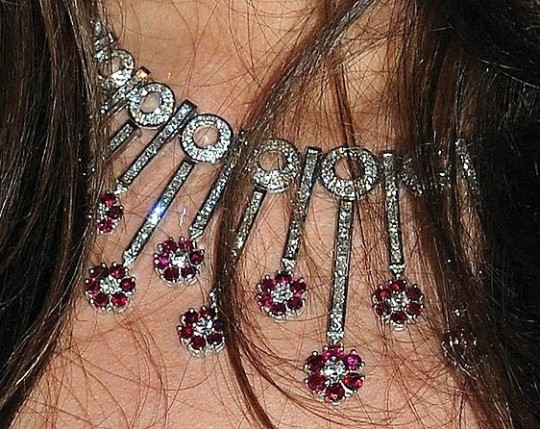
Mouawad Necklace ♕ Catherine, The Duchess of Cambridge
#kate middleton#catherine middleton#Catherine Duchess of Cambridge#ruby necklace#ruby jewelry#Diamond Jewelry#diamond necklace#royal wedding gift#royal jewels#british royal jewels#british royal family#personal property#personal jewelry#windsor royal family#windsors#house of windsor#windsor#royal windsor family#Windsor Royal Jewels#Princess of Wales#Catherine Princess of Wales
96 notes
·
View notes
Text
Thank you!😁❤️❤️❤️❤️❤️
Royal tiaras through time
Strathmore Rose Tiara worn by Queen Elizabeth, 1923
The history of royal tiaras is as long and fascinating as the headgear is sparkling. Take the tiaras worn by the late Diana, Princess of Wales, for instance. She married Prince Charles wearing a family heirloom of her own aristocratic lineage, the Spencer tiara, but the Cambridge Lovers’ Knot - with its 19 diamond arches and swinging pearls - was said to be among her favourites. (She famously teamed it with Catherine Walker’s pearl- and sequin-studded Elvis dress for a state dinner in 1989). Originally commissioned by Queen Mary, the Cambridge Lovers’ Knot was passed down to her granddaughter, Queen Elizabeth II, and has most recently been seen on the head of the Duchess of Cambridge.
Lotus Flower Tiara worn by Queen Elizabeth, circa 1930
Other British royal family sparklers of note include the Lotus Flower tiara - a favourite of Princess Margaret’s, the Egyptian-style headpiece originally belonged to the Queen Mother - and the Cartier Halo Scroll, which dates back to 1936 and was worn by the Duchess of Cambridge on her wedding day.
Cartier Halo Scroll Tiara worn by Princess Margaret, 1954
Among the oldest tiaras still in use is the Swedish royal family’s Cameo Tiara - a rich gold diadem, with seven delicate cameos framed in opulent seed pearl accents - was gifted to Empress Joséphine by Napoleon in 1809. The empress’s granddaughter, Josephine of Leuchtenberg, inherited it and took it with her into the Swedish royal family when she wed the future King Oscar I of Sweden and Norway. It has since been worn by many of the women in the household of King Carl Gustaf, from Princess Birgitta’s 1961 nuptials to Princess Victoria’s own wedding in 2010.
Not all royal households take the same inheritance approach to their gems though. The Japanese imperial household traditionally provides each family member a tiara of their own, either when they marry into the family, or when they come of age at 20. The most recent addition to the royal parure was Princess Kako of Akishino coming of age gift, an all-white scroll motif and diamond cluster set - including matching earrings, a brooch, bracelet, necklace and, of course, tiara - designed by Mikimoto.
Cameo Tiara worn by Princess Birgitta, 1961
Girls of Great Britain and Ireland Tiara worn by Queen Elizabeth II, 1961
Persian Turquoise Tiara worn by Princess Margaret, 1966
Queen Alexandra’s Kokoshnik Tiara worn by Queen Elizabeth II, 1969
Poltimore Tiara worn by Princess Margaret. 1969
Ruby & Diamond Parure Van Cleef & Arpels Set worn by Princess Grace, 1973
Braganza Tiara worn by Queen Silvia, 1976
Burmese Ruby Tiara worn by Queen Elizabeth II, 1977
Grand Duchess Vladimir Tiara worn by Queen Elizabeth, 1980
Spencer Tiara worn by Princess Diana, 1983
Princess Andrew’s Meander Tiara worn by Princess Anne, 1988
George VI Victorian Suite Tiara worn by Queen Elizabeth II, 1996
Cartier Pearl Drop Tiara worn by Princess Caroline, 1996
Four Button Tiara worn by Princess Victoria, 1997
Halo Diamond Cartier Tiara worn by Queen Rania, 2000
Diamond Floral Tiara won by Princess Dayangku Sarah Binti Pengiran Salleh Ab Rahaman, 2004
Modern Fringe Tiara worn by Princess Madeleine, 2005
Prussian Tiara worn by Princess Letizia, 2009
Cameo Tiara worn by Princess Victoria, 2010
Cartier Halo Scroll Tiara worn by the Duchess of Cambridge, 2011
Princess Mako’s Tiara worn by Princess Mako, 2011
Pearl Fleur de Lys Tiara worn by Queen Letizia, 2015
Cambridge Lover’s Knot Tiara worn by the Duchess of Cambridge, 2016
Princess Eugenie wears the Greville Emerald Kokoshnik tiara in 2019
Wonderful! Thank you so much!😁❤️❤️❤️❤️❤️
24 notes
·
View notes
Photo
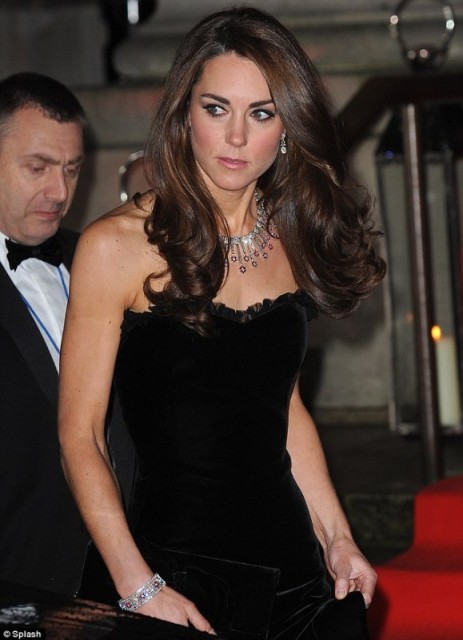




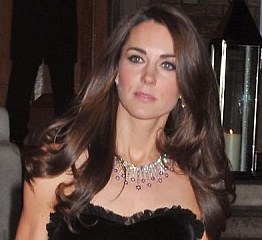

Kate’s best looks spam
Catherine, Duchess of Cambridge. “Night of Heroes" military awards event at London's Imperial War Museum, December, 2011.
These diamond and ruby pieces are speculated to be a wedding gift. I hope we see them again! Once in 6 years is not enough!!
It looks like the rays of diamonds extending off of the diamond necklace alternating long and short, each form a ruby flower with diamond center like deign at the end of the ray.
I think rubies are her stone! I know she will wear Diana’s famous sapphires, but rubies look dynomite with her skin tone and hair color!
This is by far MY FAVORITE LOOK OF KATE”S!!! She looks like a Queen!
#kate's best looks#catherine duchess of cambridge#kate middleton#duchess of cambridge#duchess kate#catherine cambridge#kate's jewels#royal jewels#rubies#diamonds
30 notes
·
View notes
Text
New world news from Time: Analyzing Every Tiara Meghan Markle Could Wear at the Royal Wedding
Not every bride has a royal wedding.
And not every woman wears a crown on her big day. But while Meghan Markle may be just a commoner like the rest of us right now, royal tradition suggests that she will wear a sparkling diamond tiara for her May 19 marriage to Prince Harry at Windsor Castle. The question, then: which tiara will she choose to top off her wedding look? The royal family has quite a collection of diadems at their disposal, many delicate pieces dating back decades — if not a century or more — and carrying the weight of tradition in their cold, hard, priceless diamond hearts. Yet rarely do tiaras see the light of day: they are only brought out for certain state occasions and weddings, like that of Kate Middleton to then-fiancé Prince William back at the royal wedding in 2011.
Assuming that Markle follows in Middleton’s footsteps, here’s our rundown of Markle’s headwear options, based on what’s available to her in the royal vault.
Spencer Tiara
Anwar Hussein—WireImagePrincess Diana, Princess of Wales, in November 1986 during a visit of Bahrain.
The Spencer Tiara is actually owned by Princess Diana’s family, the Spencers, not the royal family. It was a favorite of the late Princess Di, with its romantic curlicue design of diamond “tulips,” stars and scrolls crafted from a few other pieces of jewelry combined into this tiara form — in fact, Diana wore it on her own wedding day to Prince Charles back in 1981, giving it some extra symbolism. (Her sisters also donned it for their nuptials.) It’s currently in the possession of Diana’s father, the Earl of Spencer, and has not been worn since Princess Diana’s death in 1997, although it has appeared publicly as part of exhibitions and could potentially be loaned out for Markle.
Cambridge Lover’s Knot Tiara
Anwar Hussein—Getty ImagesDiana, Princess of Wales wears the Cambridge Lover’s Knot tiara (Queen Mary’s Tiara) and diamond earrings during a banquet on April 29, 1983 in Aukland, New Zealand.
The Cambridge Lover’s Knot Tiara is one of the most dramatic of the options in the royal arsenal, with its memorable Art Deco curlicues and height. It has an illustrious history: crafted by court jewelers Garrard in the early 1900s for Queen Mary, its design is based on a centuries-old Gothic Revival tiara first owned by Princess Augusta of Hesse. That piece is in a separate private collection, but this replica is now in the possession of the Queen, who has loaned it to both Diana and Kate over the years after wearing it herself earlier in her own reign. It consists of a mix of upright pearl drops and diamond arches, some of the pieces borrowed from other tiaras. The Duchess of Cambridge wore it as recently as 2017 at Buckingham Palace, and it was a favorite of Princess Diana’s for formal occasions. But many believe that Markle may not go this route, because it is so flashy.
Lotus Flower Tiara
DOMINIC LIPINSKI—AFP/Getty ImagesChinese President Xi Jinping (C) sits between Britain’s Catherine, Duchess of Cambridge, (L) and Britain’s Queen Elizabeth II during State Banquet at Buckingham Palace in London, on October 20, 2015, on the first official day of Xi’s state visit.
The ornate Lotus Flower Tiara was also designed by Garrard London in the 1920s of pearls and diamonds. It was a reworked wedding gift for the Queen Mother, who had a necklace dismantled and rearranged into this tiara form. She then passed it down to her daughter Princess Margaret, who wore it often and lent it to her daughter-in-law for her own wedding before it returned to the royal family vault, presumably around the time of her death in 2002. More recently, the Duchess of Cambridge has put it on display for occasions of state, including a 2013 ball and a visit from Chinese President Xi Jinping in 2015 for a Buckingham Palace banquet. It’s distinguished by the delicate lotus-shaped floral motif that makes up its signature curvy shape, making it a light but regal piece.
Strathmore Rose Tiara
The Strathmore Rose Tiara https://t.co/p4f98DrIPB pic.twitter.com/SO7TDOFIgh
— Ella Kay (@courtjeweller) February 10, 2018
The elaborate Strathmore Rose Tiara dates back to 1923, according to royal jewelry experts. It was originally a gift from the 14th Earl of Strathmore to his daughter Elizabeth upon the occasion of her marriage; she ultimately became Queen Mother, as her husband was crowned King George VI following their marriage. Since then, it has been worn sparingly by the royal family. But it is striking in design, featuring rose “prongs” set with rose-cut diamonds.
The Queen Mother’s Cartier Bandeau
One of my top choices for Meghan's wedding tiara is this sleek, sparkling bandeau from Cartier https://t.co/G8RWIujn7y pic.twitter.com/nv2ItdHMBG
— Ella Kay (@courtjeweller) January 13, 2018
The Queen Mother’s Cartier Bandeau Tiara is actually comprised of a set of bracelets, some of them also fitted with rubies, emeralds, and sapphires; for the tiara, the wearer chooses three pieces, according to Town & Country. The current Queen has been known to wear some of the different bracelet components individually over the years. It would be an unusual choice for Markle, but also a sleeker option than some of the more fanciful tiaras floating around the royal vault.
Queen Mary’s Fringe Tiara
Queen Mary's Fringe Tiara Imo it's one of the most beautiful tiaras. #tiara #tiaras #queenmaryfringetiara #queenmary #queenmum #queenmom #queenelizabeth2 #queenelizabeth #queenelizabethii #princessanne #hermajesty #hm #royals #godsavethequeen #british #britishmonarchy #crown #britishroyalfamily #weddingday #weddingdress #weddingstyle #royalwedding #britishwedding #4generations #fourgenerations#kolagemaidbaimi
A post shared by Royals of Europe (@royals.of.europe) on Jun 3, 2017 at 6:45am PDT
If Meghan Markle is looking to make a bold statement, Queen Mary’s Fringe Tiara is bound to stand out: it features a stately series of vertical rows of diamonds. Originally owned by Queen Mary according to the Royal Collection website, she lent it to her daughter-in-law Elizabeth for her wedding day. It was crafted from a diamond necklace that Queen Victoria gave to Queen Mary for her wedding back in 1893. It remains contemporary in design: minimalist in structure, maximalist in sparkle.
Out of the running: The Cartier Halo Scroll Tiara
Dan Kitwood—Getty ImagesTheir Royal Highnesses Prince William, Duke of Cambridge and Catherine, Duchess of Cambridge exit following their marriage at Westminster Abbey on April 29, 2011 in London, England.
This is the one tiara we know Meghan Markle won’t be wearing on her walk down the St. George’s Chapel aisle. The Cartier Halo Scroll Tiara, referred to as the Halo Tiara, was donned by Kate Middleton for her 2011 nuptials to Prince William at Westminster Abbey. It was a gift from the Queen Mother to Queen Elizabeth II on the occasion of her 18th birthday. But it will not be within Markle’s reach for her spring wedding, as the Queen has loaned it out to the National Gallery of Australia for a Cartier jewelry exhibition on display from March 30 through July 22.
Of course, it’s also entirely possible that Markle will choose one of the lesser-known sparklers from the extensive royal jewelry vault, transform a different piece as recent Queens have been wont to do, or even show up with a new tiara altogether. We’ll find out on May 19.
May 04, 2018 at 01:03AM ClusterAssets Inc., https://ClusterAssets.wordpress.com
0 notes
Text
Beautiful! Thank you😁❤️❤️❤️❤️
THE QUEEN’S jewelry
Nizam of Hyderabad parure
The Nizam of Hyderabad brooch’ diamonds of each rose is set in platinum, the larger one is 4.2 cm in diameter, while the two smaller ones are 3.3 cm. Each has a tremblant brilliant centre (designed to tremble when in motion, scattering light from each cut diamond). Their overlapping layers of rose pedals are pavé-set with diamond brilliants.
The Nizam of Hyderabad Tiara wasn't a set with the necklace although it was in the same general style. It was also personally chosen by the Queen from the Cartier stock, as per the Nizam’s instructions. The tiara consisted of one large and two smaller roses surrounded by leaves, all diamond-encrusted. The roses were detachable and could be worn as brooches. The Queen wore this tiara from time to time until 1973, the last time it was seen.
Duchess Catherine wearing the Nizam of Hyderabad, a diamond necklace Queen Elizabeth II received as a wedding gift for her marriage to the Duke of Edinburgh in 1947
Nizam of Hyderabad was created by Cartier in 1930s. It consists of a long chain of 38 diamonds (reduced from the original 46) with a diamond-encrusted snap. The centre of the necklace is pave-set with detachable double-drop pendant 13 emerald-cut diamonds and a pear-shaped drop. The original necklace consisted of eight double-drop and three triple-drop pendants. However, nine of the pendants (all eight double-drop and the larger of the triple-drop pendants) were later removed and sold separately. The necklace itself found its fist owner in 1936 but Cartier repurchased it a year later. The Queen has worn Nizam of Hyderabad necklace through her life, although more often in her youth. This is also one of her favourite necklaces to don when she is posing for portraits.
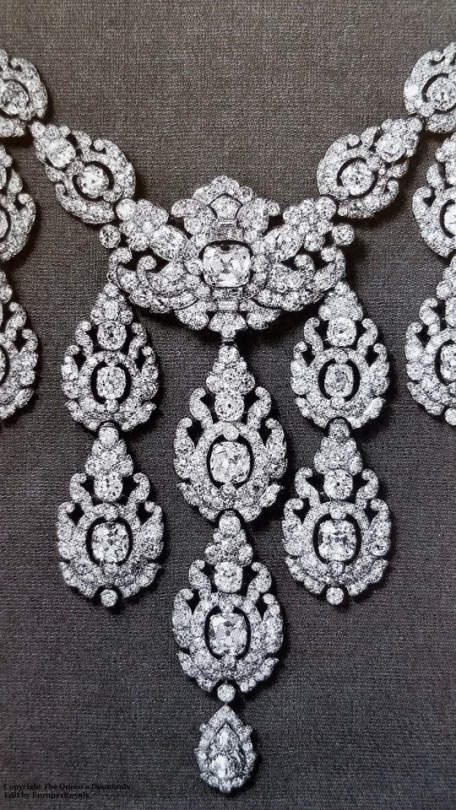
Nizam of Hyderabad Necklace (Original Form) ERJ
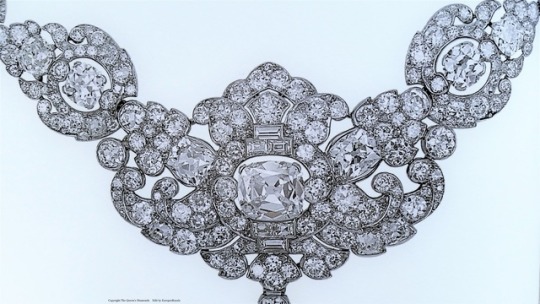
Nizam of Hyderabad Necklace, ERJ
While the necklace is still intact, the tiara is no more. It was broken up (more on that later.) All that survives are the three Nizam of Hyderabad brooches.
The brooches, and the tiara they were nestled into, were created in 1939 as general stock for Cartier, and are registered as entering the jeweller’s store in London. According to Hugh Robert’s The Queen’s Diamonds, the tiara was set with 1,033 brilliants, 84 baton diamonds and 17 diamond beads. (Cartier Archive, F.3600)
The tiara stayed on Cartier’s list of stock for the next nine years, until it was chosen as the perfect gift for a royal bride.
The Queen wearing the Nizam of Hyderabad rose tiara, a wedding gift she chose herself.
It was purchased, along with an ornate necklace, by His Highness the Nizam of Hyderabad, as a wedding present for Princess Elizabeth. The Nizam, Osman Ali Khan, was the last ruler of the Indian princely state of Nizam and Berar.
The gift is recorded in her official wedding list as No. 1331: “A Diamond Tiara, English Rose and foliage design, and a Diamond Necklace.” According to legend, the Nizam left it to Elizabeth to chose which specific Cartier necklace and tiara she wanted as a gift.
The cost was £5,000, according to an account of January, 8, 1948 (the equivalent of £173,000 in 2017)
While Queen Elizabeth wore the tiara, and its brooches, frequently in the early years of her reign, her use of the tiara trailed off as she turned to other headpieces in her royal jewellery box. After decades of rumours that it had been broken up, its demise was confirmed in Robert’s book.
It was dismantled in 1973, so its diamonds could be used in a new Burmese ruby-and-diamond tiara being made by Garrard. The three brooches escaped the jewellery chop shop.
16 notes
·
View notes